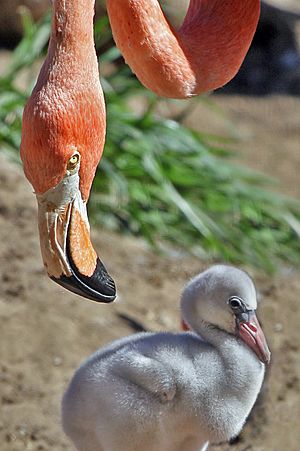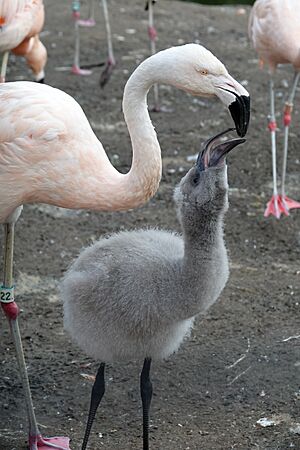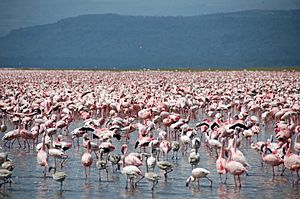Flamingo facts for kids
Quick facts for kids Flamingos |
|
|---|---|
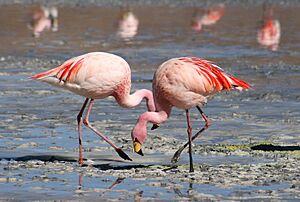 |
|
| James's flamingos (P. jamesi) | |
| Scientific classification |
|
| Kingdom: | Animalia |
| Phylum: | Chordata |
| Class: | Aves |
| Order: | Phoenicopteriformes |
| Family: | Phoenicopteridae Bonaparte, 1831 |
| Genera | |
|
|
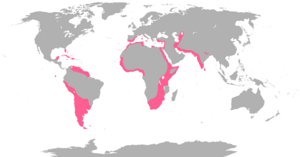 |
|
| Global distribution of flamingos | |
Flamingos are a type of wading bird known for their long legs and pink feathers. They belong to the bird family Phoenicopteridae. There are six different kinds, or species, of flamingos in the world. Four species live in the Americas (including the Caribbean), and two species live in Africa and Europe/Asia.
When you see a group of flamingos, it's called a "flamboyance"!
Contents
What's in a Name?
The name flamingo comes from Portuguese or Spanish words meaning "flame-colored." This is because of their bright, fiery pink and red feathers!
The scientific name for the main group of flamingos, Phoenicopterus, comes from ancient Greek words meaning "crimson" or "red-feathered." Other flamingo names also mean things like "crimson water nymph" or "crimson bird."
Flamingo Family Tree
Scientists have studied flamingos to understand where they fit in the bird family tree. For a long time, people thought flamingos were closely related to other long-legged birds like ibises and spoonbills.
Newer studies, especially those looking at bird DNA, show that flamingos are actually related to grebes. Grebes are diving birds that look quite different from flamingos, but they share many body features that other birds don't have. Scientists have even given a special name to the group of flamingos and grebes: Mirandornithes, meaning "miraculous birds."
Types of Flamingos
There are six main types of flamingos alive today. They used to all be in one group, but now scientists often divide them into three groups (genera).
| Image | Species | Where They Live | |
|---|---|---|---|
 |
Greater flamingo (Phoenicopterus roseus) | Old World | Found in parts of Africa, Southern Europe, and Southern/Southwest Asia. This is the most widespread flamingo. |
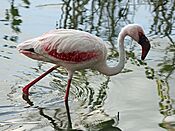 |
Lesser flamingo (Phoeniconaias minor) | Lives in Africa (like the Great Rift Valley) and Northwest India. This is the most common flamingo. | |
 |
Chilean flamingo (Phoenicopterus chilensis) | New World | Found in temperate (mild climate) Southern South America. |
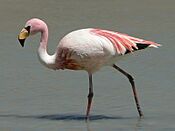 |
James's flamingo or Puna flamingo (Phoenicoparrus jamesi) | Lives high in the Andes mountains in Peru, Chile, Bolivia, and Argentina. | |
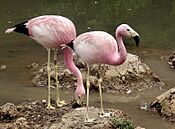 |
Andean flamingo (Phoenicoparrus andinus) | Also lives high in the Andes mountains in Peru, Chile, Bolivia, and Argentina. | |
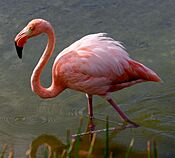 |
American flamingo or Caribbean flamingo (Phoenicopterus ruber) | Found on Caribbean islands, Caribbean Mexico, southern Florida, Belize, coastal Colombia, northern Brazil, Venezuela, and the Galápagos Islands. | |
Scientists have also found fossils of many ancient flamingo species that lived long ago, showing that these birds have been around for millions of years!
All About Flamingos
Flamingos are famous for standing on one leg. No one is completely sure why they do this! One idea is that it helps them stay warm, especially when they are standing in cold water. Another idea is that it helps them save energy and balance better. Studies have shown that they use less muscle effort when standing on one leg.
When a flamingo walks, its legs might look like they bend backward. But that's actually their ankle joint, not their knee! Flamingos also have webbed feet, which help them swim. They sometimes stamp their feet in the mud to stir up food from the bottom.
Flamingos are good at flying. In zoos, their wings sometimes need to be clipped (a harmless procedure) to keep them from flying away. One flamingo even escaped from a zoo in Kansas in 2005 and was seen in Texas 14 years later!
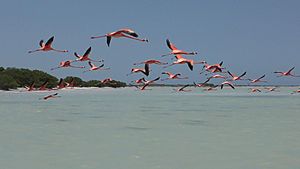
Young flamingos are born with grayish-red feathers. But adult flamingos get their famous pink or red color from the food they eat! Their diet contains special pigments called carotenoids, which are found in the tiny plants and animals they filter from the water. A healthy flamingo is usually brightly colored, which helps them find a mate. If a flamingo looks pale or white, it might be sick or not getting enough food. Flamingos in zoos might also be paler if they don't get enough carotenoids in their diet.
The Greater flamingo is the tallest species, standing about 3.9 to 4.7 feet (1.2 to 1.4 meters) tall and weighing up to 7.7 pounds (3.5 kg). The shortest is the Lesser flamingo, which is about 2.6 feet (0.8 meters) tall and weighs around 5.5 pounds (2.5 kg). Flamingos can have a wingspan from 37 inches (94 cm) to 59 inches (150 cm).
Flamingos have a unique bill that they use upside-down to filter food. They can also open their upper jaw, which is unusual for birds.
Flamingo Life
What Flamingos Eat
Flamingos are filter-feeders. This means they strain tiny food particles from the water. Their diet mainly consists of brine shrimp and blue-green algae, as well as small insects, mollusks, and crustaceans. Their bills are specially shaped to separate mud and dirt from their food. Inside their bills are tiny, hair-like structures called lamellae, which help filter the food.
The pink or reddish color of flamingos comes from the carotenoids in their diet. For example, American flamingos are a brighter red because their food has more beta-carotene. These pigments are processed by their bodies and give them their vibrant color.
Even though flamingos live in salty water, they prefer to drink fresh water. They have special glands under their eyes that remove extra salt from their bodies, allowing them to drink saltwater if needed.
Flamingo Sounds
Flamingos are quite noisy birds! They make many different sounds, from grunting and growling to nasal honking. These sounds are important for them to recognize their chicks, perform mating displays, and keep their large flocks together.
Life in a Colony
Flamingos are very social birds and live in huge groups called colonies, which can have thousands of birds! Living in large groups helps them avoid predators, find more food, and use good nesting spots more easily.
Before they breed, flamingos in a colony will split into smaller groups of about 15 to 50 birds. Both males and females in these groups perform special dances and displays together. They stretch their necks, make calls, flap their wings, and wave their heads. These displays help them find mates and encourage everyone to start nesting at the same time.
Flamingos form strong pairs for breeding. They choose a spot on a mudflat to build a nest, which looks like a small mound of mud. Both the male and female help build and protect the nest and the single egg.
After the chick hatches, both parents feed it a special "crop milk." This milk is produced in their digestive system and is full of fat and protein, similar to milk from mammals.
For the first few days, the chick stays in the nest with its parents. When they are about 7 to 12 days old, chicks start to explore. By two weeks old, they gather in small groups called "microcrèches." Later, these microcrèches join together to form huge "crèches" with thousands of chicks! This helps protect them from predators. When young flamingos are about three to three and a half months old, their flight feathers are fully grown, and they can fly.
Flamingos and People
In Zoos
Flamingos have been successfully bred in zoos for many years. The first flamingo chick hatched in a European zoo was a Chilean flamingo in Switzerland in 1958. Since then, many flamingos born in that zoo have been sent to other zoos around the world.
Zoos sometimes use mirrors in flamingo enclosures. It's thought that the mirrors make the flamingos think they are part of an even bigger flock, which encourages them to breed more.
Flamingos in History and Culture
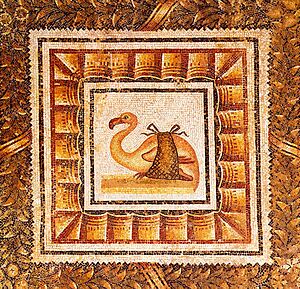
In ancient Rome, flamingos were considered a special food, especially their tongues! Famous Roman writers mentioned them in their works.
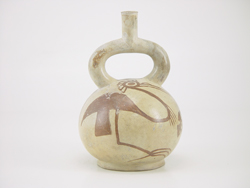
- In ancient Peru, the Moche people often showed flamingos in their art, as they worshipped nature and animals.
- The ancient Egyptian god Set is sometimes shown with a flamingo head.
- Flamingos are the national bird of the Bahamas.
- In the United States, pink plastic flamingos are popular lawn ornaments. They were first designed in 1957 and became a symbol of fun and style, especially linked to places like Florida.
Images for kids
-
Many studies suggest a link between grebes and flamingos.
See also
 In Spanish: Flamencos para niños
In Spanish: Flamencos para niños




